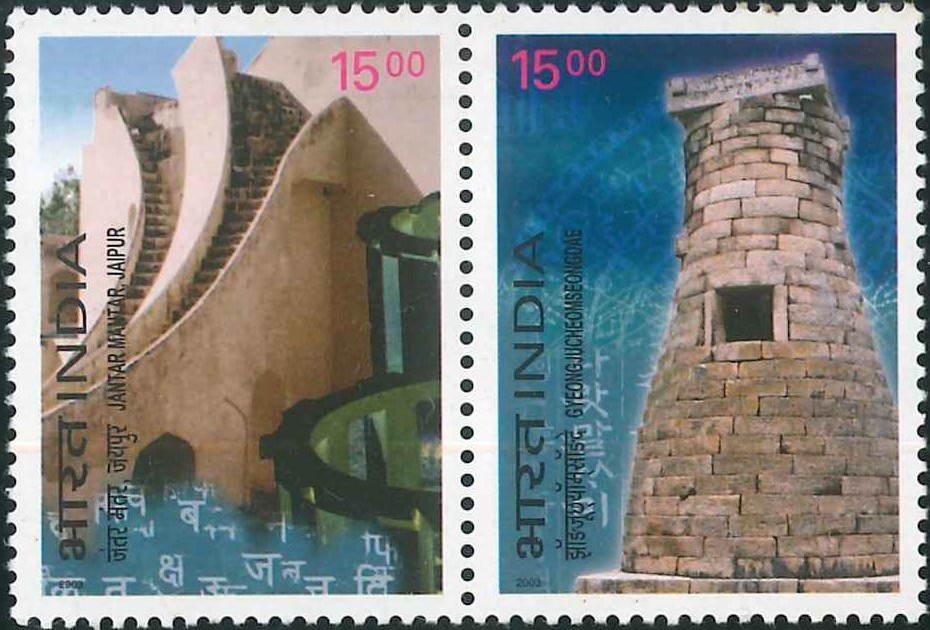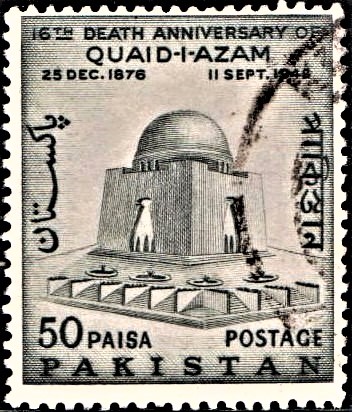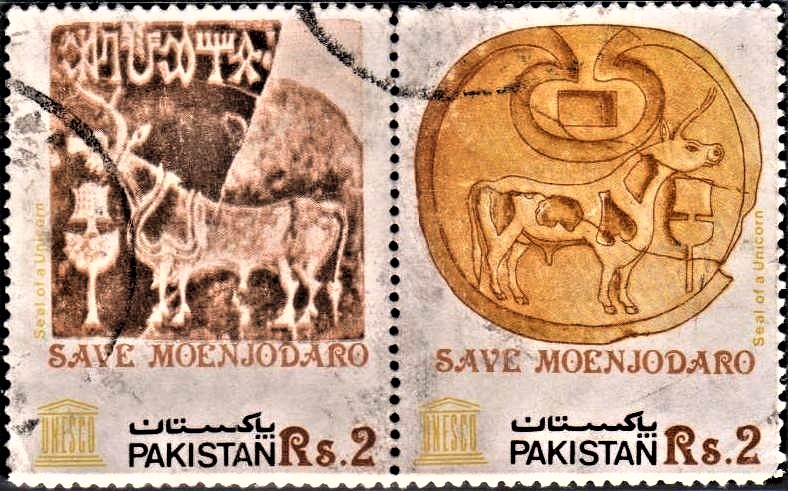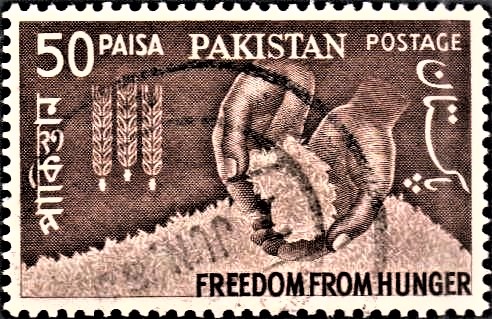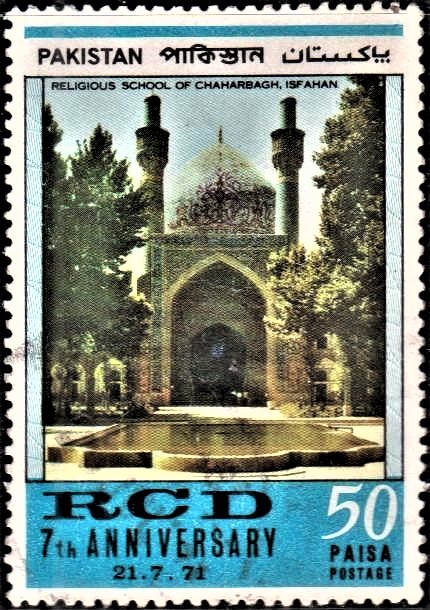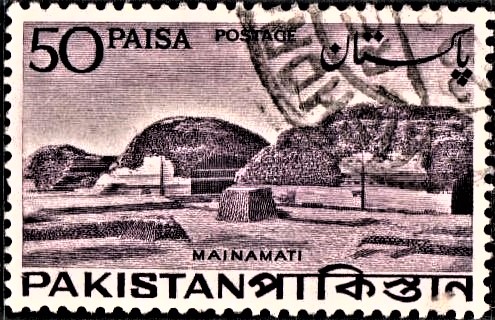
Pakistan Archaeological Series 1963
Complete set of 4 nos. of commemorative postage stamp on the Archaeological Sites of East & West Pakistan (now Pakistan and Bangladesh) : Paharpur, Mohenjodaro, Taxila and Mainamati :
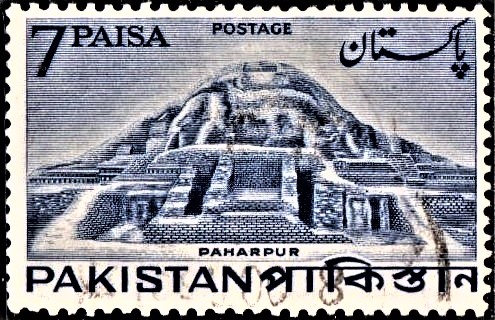
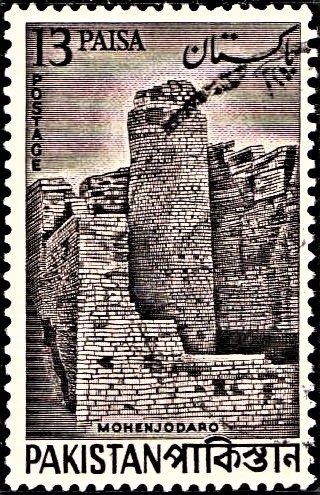

 Issued by Pakistan
Issued by Pakistan
Issued on Sep 16, 1963
Design :
7–Paisa: Depicts Buddhist Stupa at Paharpur (East Pakistan).
13–Paisa: Depicts Well at Mohenjodaro (West Pakistan).
40–Paisa: On the left is a Miniature Stupa in Mohra Moradu Monastery and on the right the Bhallar Stupa both at Taxila (West Pakistan).
50–Paisa Depicts Stupas at Kotila Mura, Mainamati (East-Pakistan).
Type : Stamps, Postal Used
Denomination : 7, 13, 40 & 50 Paisa
Colours :
7–Paisa –Ultramarine
13–Paisa – Brown
40–Paisa – Crimson
50–Paisa – Mulberry
Size of Stamps : 41 x 26 mm.
Size of Print : 38 x 23 mm.
Perforation Gauge : 14 x 12½ (c)
Quantities Printed :
7-Paisa – 10,00,000
13-Paisa – 10,00,000
40-Paisa – 5,00,000
50-Paisa – 3,00,000
Number of stamps in each sheet : 80
Process of Printing : Recess
Printers : The Pakistan Security Printing Corporation Ltd., Karachi
About :
- When the Western World was unknown to history a rich civilisation flourished in the Indus Valley about 4 to 5 thousand years ago. Excavations made have revealed Mohenjodaro to be seat of this civilisation; Taxila got the limelight about 2,000 years later on. East Pakistan being a riverine area with very soft soil and practically without mountains, the forces of nature there are too strong to allow monuments to stay on for very long. It has, however, some rich antiquities of pre-Islamic period. This series has for its motif the archaeological monuments of pre-Muslim period in the two wings of Pakistan. Mohenjodaro, Taxila, Mainamati and Paharpur have been selected as representative sites.
- Mohenjodaro: The remains of a pre-historic civilisation called the Indus Valley or ‘Mohenjodaro’ civilisation have been discovered as a result of archaeological exploration in the Indus Valley. The main centre of these remains lies on the west bank of the Indus River at a distance of 9 miles from Dokri, the nearest railway station on the Karachi–Quetta line of the Pakistan Western Railway. This buried city was discovered about quarter of a century back. It is considered as one of the most remarkable of excavated towns and the treasures of relics unearthed represent unparalleled and wonderful working of human endeavour in the remote past.
- The structural remains of Mohenjodaro present a picture of a town consisting of regular rectangular blocks, separated by broad and straight streets running from North to South and East to West. The houses constructed by kiln burnt bricks are commodious with spacious rooms arranged around a central courtyard with wells and bathrooms built in one corner. The stair-cases indicate the presence of upper storey. The city had an elaborate drainage system. The street drains, soak-pits and manholes were all brick-lined and covered.
- The river Indus afforded facilities for transport, trade and irrigation. The inhabitants cultivated wheat, barley, rice, peas, sesames and cotton. The dietary include milk, vegetables, fruits, beef, mutton, pork, poultry and fish. The common dress seems to have been of cotton embroidered with designs. Both male and female were fond of ornaments made of semi-precious stones, gold, silver, bronze, shell, ivory and clay. Pottery includes every form from storage jars down through tiny vases. Games and sports articles consisted of marbles, balls, dice and casting sticks. Hunting and fishing was regular occupation. Toys of different types and toy-carts in particular were common. Worship of human/animal figures, pipal tree and snake appears to be there. The Mohenjodaro civilisation declined after 2000 B.C. for reasons not at present known but the developed culture was in no way inferior to the contemporary civilisation of Mesopotamia.
- Taxila: The excavated remains at Taxila and a number of monasteries and stupas in the North West, although separated by lofty Himalayas and the Hindukush ranges from the neighbouring cities of Central Asia, all from part of one and the same Buddhistic Civilisation that flourished in these regions. These Buddhist remains represent their largest visible assemblage in the Indo-Pakistan sub-continent. The first city of Taxila or Bhir Mound as it is now known has preserved little to show. It was greatly disturbed by the invasion of Alexander the Great in 326 B.C. The conquest of Alexander was short-lived but the Greek influence did spread across the Hindukush into Pakistan. In the second century B.C. partially Hellenized Scythians reached Taxila and rebuilt the city on a new site (Sirkap), and as again rebuilt by their Parthian successors in the following century, its streets and houses are today, after extensive excavation, one of the very rare archaeological sights of the sub-continent. The long straight main streets, flanked by shops, shrines and a palace, is the axis of a regular, rectilinear plan like that of a Greek city of the West. Probably towards the end of the second century A.D., the city was yet again rebuilt, this time by great Kushans with elaborate defences of which a part has been exposed to view by Archaeologists. Meanwhile, great numbers of Buddhist monasteries had been growing up in the surrounding country side and drew numerous students. For many centuries the University of Taxila was famous amongst the Universities of Asia. The end of Taxila came by violence. Soon after the middle of the fifth century A.D., the White Huns swept down from Central Asia and Taxila with its monasteries was put to sword and fire.
- Paharpur: Buddhism in East Pakistan would appear to go back to Asoka, the Mauryan Emperor, as certain stupas there, according to Hiuen Tsang, had been founded by that Emperor. One of these was in the vicinity of Pundra Nagar (near Bogra) and was a magnificent Buddhist establishment, with spacious halls, tall storeyed chambers and more than 700 monks. The immense scale of some of the Buddhist monasteries under the wealthy patronage of the Pala Kings, however, is best represented by the Somapura Vihara established by Dharama Pala about 800 A.D. The monastery is known today from the adjacent village of Paharpur (Rajshahi District); and this in turn derives its name from the Pahar or Hill which preserved the central shrine. Here, amidst tall sugar cane and jute fields, grain and roots, are the excavated remains of the largest known monastery south of the Himalayas. This monastery is nearly 1,000 feet square, with the central stupa still seventy feet high, terraced and adorned with long lines of sculptures, mostly of terracotta.
- Mainamati: On the flat tops and slopes of the picturesque hills in Mainamati–Lalmai ridge near Comilla, has been discovered another extensive centre of Buddhist Culture. More than 50 sites of varying sizes and importance are found buried all over the ridge. Excavations in three of these sites have exposed a large monastic establishment known as Salban Vihara, a group of three stupas at Kotila Mura and a shrine at Charpatra Mura. These excavations have yielded a rich harvest of valuable antiquities. They include copper plates, hoards of gold and silver coins, relic caskets, bronze images of Buddha, Bodhistava and goddesses Tara and Sarvani, stone sculptures, terracotta sealings, clay, votive stupas, terracotta plaques and carved bricks, pottery and miscellaneous objects of daily use. Terracotta sculptures, like those found in Paharpur, depict a true picture of the social life of the people of East Pakistan of those days and help to throw light on the history of the place and the religion practised in this region. They also cover a large number of subjects such as musicians, dancers, warriors, semi-divine beings, animal fables and birds. The evidence from relics discovered from excavations lend support to the views that Buddhist Monuments on Mainamati hills were established at some stage during the 7th-8th centuries A.D.
- With the compliments of the Director-General, Pakistan Post Office, Karachi.


